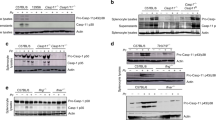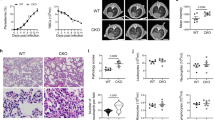Summary
There are many similarities in the pathophysiology of gram-negative infections and in acute falciparum malaria. Particularly, noteworthy is the detection of circulating inflammatory mediators in animals receiving endotoxin and in animals infected with malarial parasites. These observations have lead to the notion that macrophage derived mediators may be responsible, at least in part, for the pathology observed in malaria.
Similar content being viewed by others
References
Cannon RR (1941) Some pathological aspects of human malaria. In: Moulton FR (ed) A symposium of human malaria. Am Assoc Adv Sci, Washington DC, pp 214–220
Kitchen SF (1949) Falciparum malaria. In: Boyd MF (ed) Malariology, vol II. WB Saunders, Philadelphia, pp 995–1006
Clark IA, Allison AC, Cox FEG (1976) Protection of mice againstBabesia andPlasmodium with BCG. Nature 259:309–311
Clark IA, Cox FEG, Allison AC (1977) Protection of mice againstBabesia spp andPlasmodium spp with killedCorynebacterium parvum. Parasitology 74:9–18
Herod E, Clark IA, Allison AC (1978) Protection of mice against the haemoprotozoanBabesia microti withBrucella abortus strain 19. Clin Exp Immunol 31:518–523
Clark IA (1979) Resistance toBabesia spp andPlasmodium sp in mice pretreated with an extract ofCoxiella burneti. Infect Immun 24:319–325
Clark IA (1979) Protection of mice againstBabesia microti with cord factor, COAM, zymoson, glucan,Salmonella andListeria. Para Immunol 1:179–197
Clark IA, Wills EJ, Richmond JE, Allison AC (1977) Suppression of babesiosis in BCG-infected mice and its correlation with tumor inhibition. Infect Immun 17:430–438
Clark IA, Richmond JE, Wills EJ, Allison AC (1977) Intra-crythrocytic death of the parasite in mice recovering from infection withBabesia microti. Parasitology 75:189–196
Clark IA (1978) Does endotoxin cause both the disease and parasite death in acute malaria and thromboxane? Lancet 2:75–77
Clark IA, Clouston WM (1980) Effects of endotoxin on the histology of intact and athymic mice infected withPlasmodium vinckei petteri. J Pathol 131:221–234
Carswell EA, Old LJ, Kassel RL, Green S, Fiore N, Williamson B (1975) An endotoxin-induced serum factor that causes necrosis of tumours. Proc Natl Acad Sci USA 72:3666–3670
Moore RN, Goodrum KJ, Berry LJ (1976) Mediation of an endotoxic effect by macrophages. J Reticuloendothel Soc 23:321–332
Männel DN, Farrar JJ, Mergenhagen SE (1980) Separation of a serum-derived tumoricidal factor from a helper factor for plaqueforming cells. J Immunol 124:1106–1110
Salvin SB, Youngner JS, and Lederer WH (1973) Migration inhibition factor and interferon in the circulation of mice with delayed hypersensitivity. Infect Immun 7:68–75
Shands JW, Senterfitt VC (1972) Endotoxin-induced hepatic damage in BCG-infected mice. Am J Pathol 67:23–40
Shands JW, Miller V, Martin H, Senterfitt V (1969) Hypoglycaemic activity of endotoxin II. Mechanism of the phenomenon in BCG-infected mice. J Bacteriol 98:494–501
Clark IA, Virelizer J-L, Carswell EA, Wood PR (1981) Possible importance of macrophage-derived mediators in acute malaria. Infect Immun 32:1058–1066
Geczy CL, Hopper KE (1981) A mechanism of migration inhibition in delayed-type hypersensitivity reactions II. Lymphokines promote procoagulant activity of macrophages in vitro. J Immunol 126:1059–1065
Maegraith B (1948) In: Pathological processes in malaria and blackwater fever. Blackwell, Oxford, p 345
Passwell JH, Dayer J-M, Merler E (1979) Increased prostaglandin production by human monocytes after membrane receptor activation. J Immunol 123:115–120
Adam C, Geniteau M, Gougerat-Pacidalo M, Verroust P, Lebras J, Gilbert C, Morel-Maroger L (1981) Cryoglobulins, circulating immune complexes, and complement activation in cerebral malaria. Infect Immun 31:530–535
Holtzman S, Schuler JJ, Earnest W, Erve PR, Schumer W (1974) Carbohydrate metabolism in endotoxemia. Circ Shock 1:99–105
Clark IA (1982) Correlation between susceptibility to malaria and babesia parasites and to endotoxicity. Trans R Soc Trop Med Hyg (in press)
Heyman A, Beeson PB (1949) Influence of various disease states upon the febrile response to intravenous injection of typhoid bacterial pyrogen. J Lab Clin Med 34:1400–1403
Rubenstein M, Mulholland JH, Jeffery GH, Wolff SM (1965) Malaria induced endotoxin tolerance. Proc Soc Exp Biol Med 118:283–287
Sinton JA, Harbhagivan S, Singh J (1931) The numerical prevalence of parasites in relation to fever in chronic benign tertian malaria. Ind J Med Res 18:871–879
Hill RB, Cambourmac FJC, Simoes MP (1943) Observations on the course of malaria in children in an endemic region. Am J Trop Med Hyg 12:147–162
Kitchen SF (1949) Symptomology: general considerations. In: Boyd MF (ed) Malariology, vol II. WB Saunders, Philadelphia, pp 966–994
Murphy PA, Simon PL, Willoughby WF (1980) Endogenous pyrogens made by rabbit peritoneal exudate cells are identical with lymphocyte activating factors made by rabbit alveolar macrophages. J Immunol 124:2498–2501
McAdam KPWJ, Dinarello CA (1980) Induction of serum amyloid A synthesis by human leukocytic pyrogen. In: Agarwal MK (ed) Bacterial endotoxin and host response. Elsevier/North Holland Amsterdam, pp 167–178
Sztein MB, Vogel SN, Sipe J, Murphy PA, Mizel S, Oppenheim JJ, Rosenstreich DL (1981) The role of macrophages in the acute phase response: SAA inducer is closely related to lymphocyte activating factor and endogenous pyrogen. Cell Immunol 63:164–176
McAdam KPWJ, Westermark P, Anders RF, Voller A (1979) Juvenile amyloidosis in the Anga peoples of Papua New Guinea. In: Glenner CG, Pinhe e Costa P, Freitas AF de (eds) Proc 3rd Int Symp on Amyloidosis, Portugal. Excerpta Medica, Amsterdam, pp 207–210
Coleman RM, Bruce A, Rencricca NJ (1976) Malaria: macrophage migration inhibition factor (MIF). J Parasitol 62:137–138
Dennis LH, Eichelberger JW, Inman MM, Conrad ME (1967) Depletion of coagulation factors in drug-resistantPlasmodium falciparum malaria. Blood 29:713–721
Kontos HA, Wei EP, Povlishock JT, Dietrich WD, Magiera CJ, Ellis EF (1980) Cerebral arteriolar damage by arachidonic acid and prostaglandin G2. Science 209:1242–1245
Wei EP, Kontos HA, Dietrich WD, Povlishock JT, Ellis EF (1981) Inhibition by free radical scavengers and by cyclooxygenase inhibitors of pial arteriolar abnormalities from concussive brain injury in cats. Circ Res 48:95–103
Maegraith B, Fletcher A (1972) The pathogenesis of mammalian malaria. Adv Parasitol 10:49–75
Author information
Authors and Affiliations
Rights and permissions
About this article
Cite this article
Clark, I.A. Suggested importance of monokines in pathophysiology of endotoxin shock and malaria. Klin Wochenschr 60, 756–758 (1982). https://doi.org/10.1007/BF01716573
Issue Date:
DOI: https://doi.org/10.1007/BF01716573




